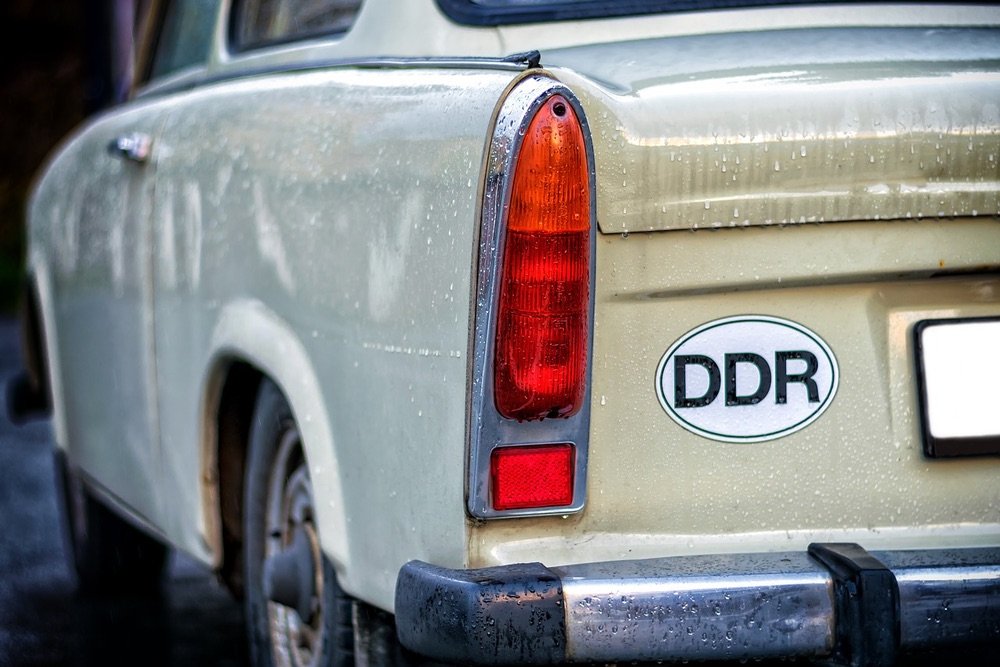
It was typical for the GDR leadership to try to connect the population and the authorities. Thus, on 25 September 1952, the People’s Police Volunteers organisation was created. The members served on a voluntary basis. Order No. 152/52 from the Chief of the barracked People’s Police (KVP) on 10 December 1952 established the structure and organisation of the Section Officers. These ABVs were to form the link between the VP and the helpers.
The official task of the helpers was to support the People’s Police in fighting crime and guarding public property. In public manhunts, they reinforced the People’s Police with patrols.
On 17 June 1953, they went on unarmed patrol. They were only involved as informants in the suppression of the workers’ protests. But that was enough to get many people into trouble.
The distribution of tasks changed according to current requirements. Thus, the helpers were on border surveillance duty when the Wall was built. Later, too, they remained active in monitoring the border areas, but this was more the task of the volunteer helpers of the border troops.
Most of the time, the citizen met the helpers as foot patrols. Thus one of their nicknames was “the walkers”. Others were far less nice. The volunteers of the People’s Police also had the right to monitor road traffic. This made them less popular with motorists. In addition, many helpers made themselves quite important.
In 1959 it became necessary to bring under control some helpers who saw themselves as counterparts to the members of the volunteer operational Komsomol brigades of the Soviet militia. They demanded a considerable extension of their competences from the Ministry of the Interior. They even suggested arming them. The MdI reacted, contrary to their expectations, with the clear instruction that the helpers were only allowed to operate under the direct guidance of a Volkspoliz officer.
The problem was that they were taught to be educational. Every aid worker had a different view of what that meant. From 1964 onwards, further ordinances followed to better regulate the helpers.
Some of the tasks of the helpers are absolutely not police tasks nowadays, such as monitoring the fulfilment of the plan in the factory. They showed up in the factories and walked around in the residential areas and interfered in things that were not part of their normal patrol duties. Some of them invaded the privacy of the citizens. Some even listened at the doors for “West television”.
With effect from 1 May 1982, the Council of Ministers of the GDR issued the last decree in which the volunteers of the People’s Police and the border troops, who had previously been treated together, were now treated separately.
The organisation was based on that of the National People’s Army. There were three group leaders for every platoon leader. Nine volunteers belonged to each group. Incidents were to be reported to the ABV. The ABV was usually located in the police station in charge. He officially passed on the report of the helpers to the People’s Police.
Every People’s Police officer was authorised to give instructions to the helpers. For example, in the case of “imminent danger”, even without informing the ABV in advance.
TheOrdinance on the Volunteers of the German People’s Police contained for the first time a catalogue of powers as well as the concrete conditions for employment and the principles of mediation. In principle, any GDR citizen over the age of 18 who was loyal to the party and the state could become a helper.
One of the most unpopular tasks of the helpers among the population was monitoring the house books. Who came to visit, did they even have contacts with the West?
While real police officers could be prosecuted for exceeding their authority, there were no regulated official penalties for helpers. The only punishment was dismissal or a verbal warning with its threat. waren möglich.
However, the volunteers, like all citizens, were subject to criminal law. Measures were only to be taken to the extent that they appeared necessary to avert danger or to eliminate disturbances in the interest of restoring public order and safety.
A blue memory booklet contained 89 alphabetically arranged situations. Eager helpers learned them from A like ash deposit up to Z like Bringing suspected persons to the VP by heart. However, there was no test.
Helpers were not allowed to record reports, that was the sole task of the VP. However, the helper independently secured the crime scene. He made sure that no changes were made. Exceptions were the covering of “inflammatory slogans” and the removal of “anti-class propaganda writings”.
It should come as no surprise to anyone that the state security had its fingers in the helper organisation from the very beginning. Helpers were deliberately placed to monitor their own ranks. One can only speculate about the number of these unofficial collaborators. In the regular People’s Police, the number was up to 40 %, according to an evaluation of the files.
The service of volunteers in the Criminal Investigation Department was a classified matter of the Ministry of the Interior. Their deployment was always a confidential service matter. The head of the criminal investigation department or his deputy was directly responsible for the necessary political and technical training and for the actual work of the volunteers with the criminal investigation department.
The criminologists gave their orders and instructions to the volunteers, accounted for the work results and prepared an assessment of these results once a year. The special feature was that the placement of orders was explicitly only verbal had to be done. This made it easier to write the reports later in the sense of the MDI.
A special task was to control compliance with conditions, such as residence and contact bans, for former prisoners. Officially, the aim was to prevent new crimes and to prevent the spread of anti-state opinions. Since many of those monitored had been in prison for Republikflucht or political “crimes”, many reports went directly to the state security.
Company managers, cooperative board members and other leaders were to be advised by helpers in order to examine the causes and possibilities for criminal offences in the companies. Since the helpers themselves often lacked professional training, they were not welcome guests. This was especially true for members of their own company who, as voluntary helpers of the People’s Police, also had to be released from work. Since this often hindered the fulfilment of the socialist plan, they were also unpopular for very practical reasons.
The total number of helpers in the 1980s was over 150,000. Most of them were members of the SED. Many took part because they wanted to study. Other helpers wanted to become People’s Police officers. As there was no specific oath, many saw the activity as a hobby and of course the service also attracted people with power fantasies.
Apart from a few information sessions, the volunteer learned by doing. Over the years, more and more information sessions were added, but never real training.
The helpers did not have uniforms but wore a red wristband with the emblem of the People’s Police and the inscription “Helfer der Volkspolizei” on the left upper arm: Helpers of the People’s Police on the left upper arm. Since they looked like normal citizens without the bracelet, the feeling of omnipresent state surveillance was intensified. At any time, a passer-by could pull out such a band and become a Volkspolizei helper. On patrol, the helper carried a shoulder bag with a notepad and writing utensils. They also had a whistle and a service ID. Many had self-procured boots.
In the traffic service, the “regulation baton” was part of signalling to motorists. Moped and motorbike riders had a service helmet. Many helpers had self-procured tools with them, pliers, pocket knives and torches.
As the GDR state system began to collapse, the tasks assigned to the volunteers were increasingly curtailed. Many tasks were transferred to the armed fighting groups of the working class.
The volunteers, long treated by most citizens as persons of respect, were now, representative of the hated GDR regime, became the laughing stock of the citizens. Their instructions were hardly followed and quite a few were beaten up in dark corners.
In the area of the Dresden district, the volunteer helpers of the People’s Police had already been dissolved in practice by the end of December 1989. One reason was that the companies no longer saw any incentive in releasing the volunteers from their work for 8-10 hours a week. The system of section officers collapsed completely during the reunification period until the middle of 1990, and there were no superiors.
On 13 September 1990, with effect from 1 October 1990, the GDR Council of Ministers passed the “Law on the Tasks and Powers of the Police”,
The new law was an interim solution and was to be valid until the respective police laws of the federal states came into force. When the law came into force on 1 October, the previous “Ordinance on the Volunteers of the German People’s Police” of 1 April 1982 automatically expired at midnight on 30 September 1990. The consequence of this was that from 1 October 1990, the volunteers were were without legal basis. Thus, the dissolution can be dated 30 September, even if it did not happen directly.
In addition to the helpers of the normal People’s Police, there were also similar organisations. For example, there were the volunteers of the dyke defence service who checked the condition of dykes and dunes on the Baltic Sea coast and in the Oderbruch. But they were subordinate to the fire brigade and had no police powers.
At the Transport Police (Trapo), to which the railway police belonged, there were volunteers of the transport police. They wore the same armband as the helpers of the People’s Police, in the case of railwaymen to the service uniform.



